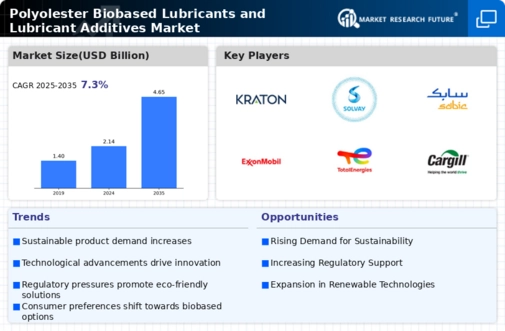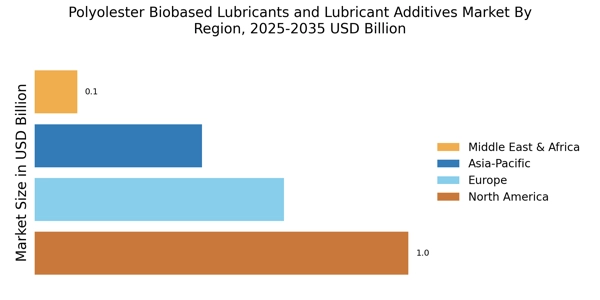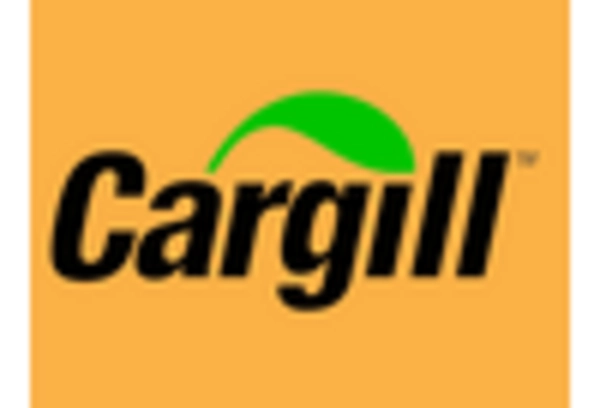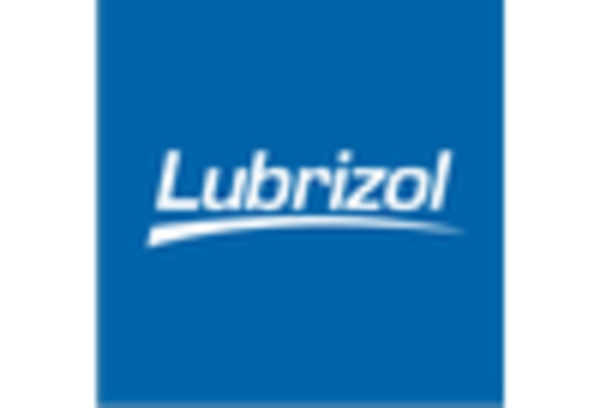Consumer Awareness
Growing consumer awareness regarding the environmental impact of traditional lubricants is a key driver for the Polyolester Biobased Lubricants and Lubricant Additives Market. As consumers become more informed about the benefits of biobased products, there is a noticeable shift towards purchasing sustainable alternatives. Surveys indicate that over 60% of consumers are willing to pay a premium for eco-friendly lubricants, which is likely to boost demand in the market. This trend is expected to contribute to a market growth rate of approximately 5% annually. The increasing preference for sustainable products among consumers is compelling manufacturers to innovate and expand their offerings in the Polyolester Biobased Lubricants and Lubricant Additives Market, thereby fostering a more competitive landscape.
Regulatory Support
Regulatory support for environmentally friendly products is increasingly influencing the Polyolester Biobased Lubricants and Lubricant Additives Market. Governments worldwide are implementing stringent regulations aimed at reducing the environmental impact of lubricants, which is driving the adoption of biobased alternatives. Policies promoting the use of renewable resources and penalizing the use of petroleum-based products are likely to enhance market growth. In 2025, it is anticipated that regulatory frameworks will further favor biobased lubricants, potentially increasing their market share by 10%. This supportive regulatory environment not only encourages manufacturers to invest in the development of polyolester lubricants but also reassures consumers about the sustainability of their choices within the Polyolester Biobased Lubricants and Lubricant Additives Market.
Diverse Applications
The versatility of polyolester biobased lubricants is a significant driver for the Polyolester Biobased Lubricants and Lubricant Additives Market. These lubricants are utilized across various sectors, including automotive, aerospace, and industrial machinery, due to their superior performance characteristics. For example, in the automotive sector, polyolester lubricants are favored for their high thermal stability and low volatility, which enhance engine efficiency. The market is projected to expand as more industries recognize the benefits of these lubricants, with an estimated growth of 6% per year. This diverse applicability not only broadens the customer base but also encourages innovation within the Polyolester Biobased Lubricants and Lubricant Additives Market, as manufacturers seek to tailor products to specific industry needs.
Sustainability Focus
The increasing emphasis on sustainability is a primary driver for the Polyolester Biobased Lubricants and Lubricant Additives Market. As industries strive to reduce their carbon footprints, the demand for biobased lubricants has surged. These products are derived from renewable resources, which aligns with the global shift towards environmentally friendly practices. In 2025, the market for biobased lubricants is projected to reach approximately USD 2 billion, reflecting a compound annual growth rate of around 8%. This growth is indicative of a broader trend where companies are prioritizing sustainable materials in their operations. The Polyolester Biobased Lubricants and Lubricant Additives Market is thus positioned to benefit from this heightened awareness and commitment to sustainability, as consumers and businesses alike seek greener alternatives.
Technological Advancements
Technological advancements play a crucial role in shaping the Polyolester Biobased Lubricants and Lubricant Additives Market. Innovations in formulation and production processes have led to the development of high-performance biobased lubricants that meet stringent industry standards. For instance, advancements in esterification techniques have improved the efficiency and effectiveness of polyolester lubricants, making them suitable for a wider range of applications. The market is expected to witness a growth rate of approximately 7% annually, driven by these technological improvements. Furthermore, the integration of smart technologies in lubricant formulations is anticipated to enhance performance characteristics, thereby attracting more users to the Polyolester Biobased Lubricants and Lubricant Additives Market. This trend suggests that ongoing research and development will continue to propel the market forward.


















Leave a Comment